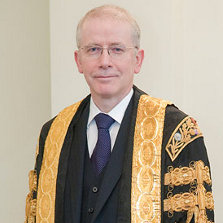Share it
 Lord Reed spoke on the evening of Monday 11 February at Balliol College, Oxford, giving a presentation entitled “The Supreme Court: An Inside View”.
Lord Reed spoke on the evening of Monday 11 February at Balliol College, Oxford, giving a presentation entitled “The Supreme Court: An Inside View”.
Returning to the college where he completed his DPhil (under the supervision of Professor Paul Craig), Lord Reed began by setting out differences between the UK Supreme Court and highest appellate courts around the world. Lord Reed noted that the Supreme Court deals with all manner of issues (whereas other courts are limited to constitutional matters, for instance); selects which cases to hear on the basis of leave applications; serves other jurisdictions (when constituted as the Privy Council); has no power to strike down laws (though this is arguably qualified by the Court’s obligations under European Union law and the European Court of Human Rights); and is the final interpreter of legislation. He made some interesting observations about the range of cases that make their way to the Supreme Court, observing that some common law cases are rather like exploring the history of ideas – an idea’s past must be investigated and put into context, before a decision is made.
Moving to details of the Court’s operation, his Lordship pointed out that the Court is now interestingly situated opposite Parliament, and with the Church and the Treasury buildings on either side of it. Lord Reed explained that the Court has underscored the importance of transparency and accessibility, as demonstrated in its high numbers of visitors every year. He also pointed out that the Court has a programme of meetings with overseas judges. Turning to the process of hearing a case, Lord Reed said hearings were a bit like “being in a seminar”, with meetings preceding the hearing, following the hearing, and an attempt being made to ensure deliberation in the course of a hearing. He touched on the process of drafting a judgment, which he said often involved multiple drafts, and mentioned that the Supreme Court is concerned to ensure that dissents make clear any points of disagreement.
Addressing the judicial makeup of the Court, Lord Reed acknowledged that there was just one woman on the Court, Lady Hale. He pointed out that the judges did come from quite diverse intellectual backgrounds, although he was careful to note that the process of appointment was not as political as in the United States. He emphasised that judgment-writing was a “team effort” – something that he appeared to be grateful for, in light of the large number of judgments produced.
Reflecting on whether his DPhil at Oxford had prepared him well to be a Justice of the Supreme Court, Lord Reed did note that four skills acquired while writing a doctorate had proved to be valuable: the ability to condense huge amounts of material; the ability to write clearly and logically; the capacity to concentrate for a sustained period of time; and confidence in presenting views.
Overall, Lord Reed offered in this speech a candid and informative picture of the operation of the Supreme Court – which highlighted the Court’s ongoing commitment to be accessible to the public, while also illustrating his thoughtfulness about the judicial role.



1 comment
Ray said:
17/02/2013 at 03:04
Can the transcript of the speech be posted here?